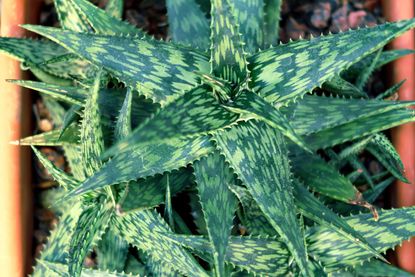Variegated Tiger Aloe: How To Care For A Tiger Aloe Plant


Spiky leaved aloe plants are a spectacular addition to the warm season landscape and provide interest to container gardens. Tiger aloe plants (Aloe variegata), with their streaked leaves and salmon pink flowers, will amaze the succulent lover. This unique cultivar is also known as Partridge Breast aloe. Learn how to care for a tiger aloe and enjoy the leaves and plume-like flowers of this attractive plant.
Tiger Aloe Information
Tiger aloe will amaze and delight the gardener with a penchant for succulents. This variety has the classic sword-shaped thick leaves and healing sap boasted by more common varieties. Variegated tiger aloe blooms from July through September in its native habits of Namibia and South Africa. Home grown plants will produce similarly with good care and bright sunlight. The arrangement of the leaves provides an interesting tidbit of tiger aloe information. They are generally produced in three sets of six to eight leaves around a central rosette. The slightly serrated edges and thick waxy coated foliage sport mottled white and green patterns. Tiger aloe plants may get 12 inches (30 cm.) high and around 9 inches (22 cm.) wide. The flowers are borne on a stiff slender stalk and may be pink, orange, or a salmon pink. Leaves are 4 to 6 inches (10-15 cm.) long and just a couple of inches (5 cm.) wide. In their natural range, they are found in gritty soils where rainfall is infrequent. They can withstand periods of drought by storing moisture in their leaves and conserving it with a waxy cuticle over the foliage.
How to Care for a Tiger Aloe
Tiger aloe has the same requirements as other succulent aloes. The plant is suited for warmer zones and may be taken outside in summer in cooler areas. Don't forget to bring it in when cold temperatures are approaching, as the plant is only hardy in USDA zones 9 to 11. The majority of gardeners will find it easier to grow the plant inside alone in a container or as part of a succulent display. Water deeply but rarely and let the soil dry out between watering. The plant grows slowly but should be repotted every three years in a good mix of potting soil and sand or cactus mix. The biggest problem that occurs with aloe plants is overwatering, which can cause the plant to rot.
Growing Tiger Aloe from Offsets
A fun thing about these plants is their ability to produce fully vegetative babies or offsets for propagation. Divide these away from the parent plant and place them in a container. They will root quickly and provide you with more of this amazing plant to populate your landscape or give away to an appreciative friend. The easiest way to propagate the plant is by growing tiger aloe from the babies at its edges. They should pull away fairly easily or you can cut them cleanly from the parent.
Gardening tips, videos, info and more delivered right to your inbox!
Sign up for the Gardening Know How newsletter today and receive a free download of our most popular eBook "How to Grow Delicious Tomatoes."

Bonnie Grant is a professional landscaper with a Certification in Urban Gardening. She has been gardening and writing for 15 years. A former professional chef, she has a passion for edible landscaping.
-
 Shrub Diseases And Pests To Watch Out For
Shrub Diseases And Pests To Watch Out ForShrub diseases and pests can be challenging. Learn how to recognize and eradicate them before they can present a danger to your plants.
By Susan Albert
-
 Foodscaping: The Most Beautiful Way To Grow Your Own Food
Foodscaping: The Most Beautiful Way To Grow Your Own FoodFoodscaping is a beautiful and profoundly practical way to mix beauty and function in your yard. Try food landscaping for a real sense of abundance.
By Bonnie L. Grant